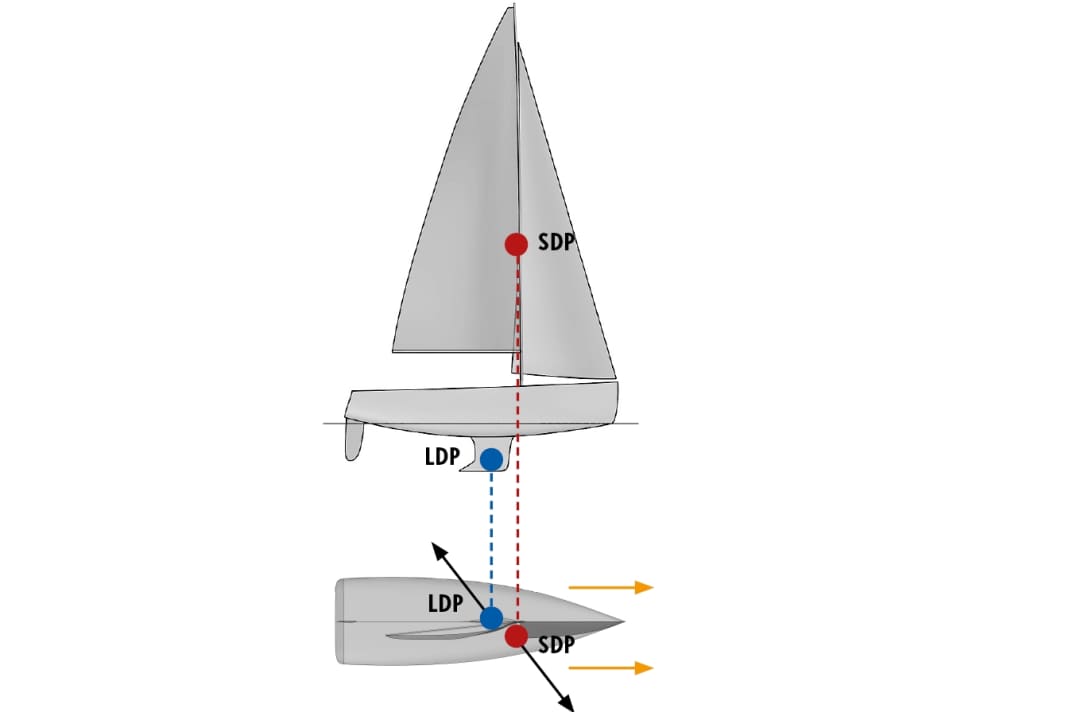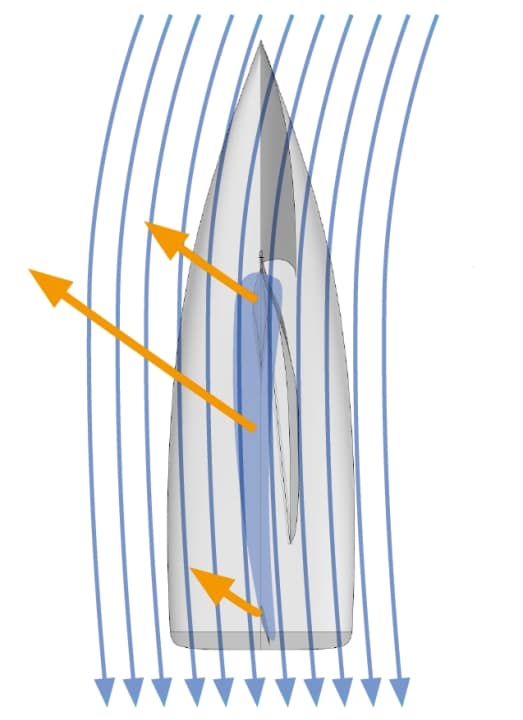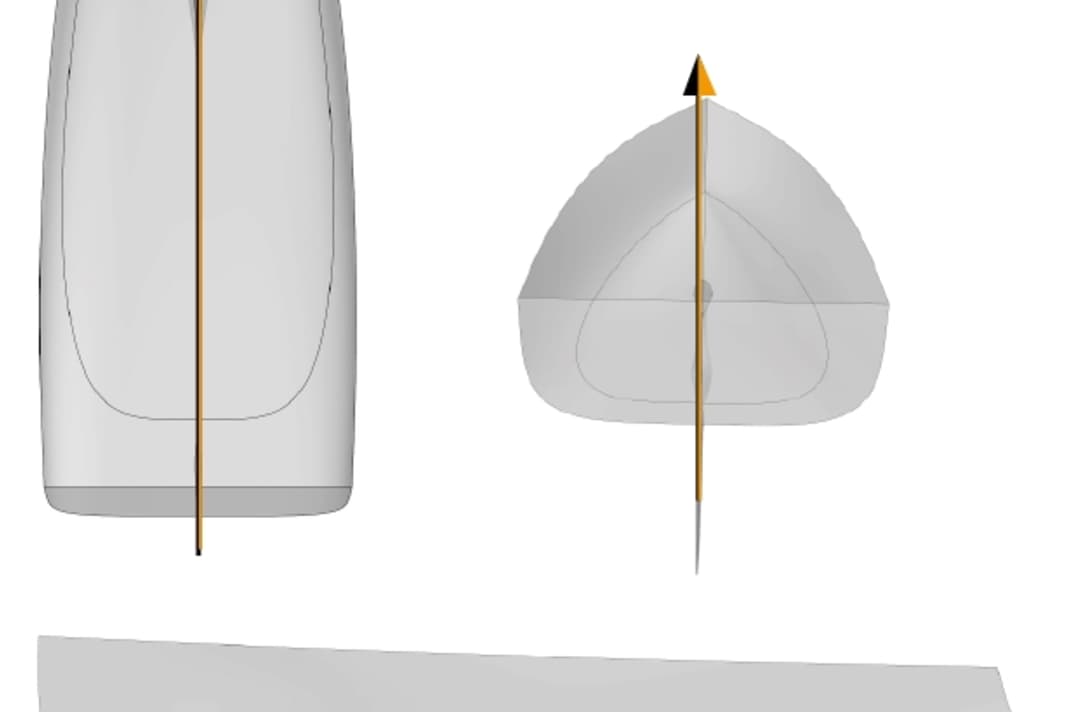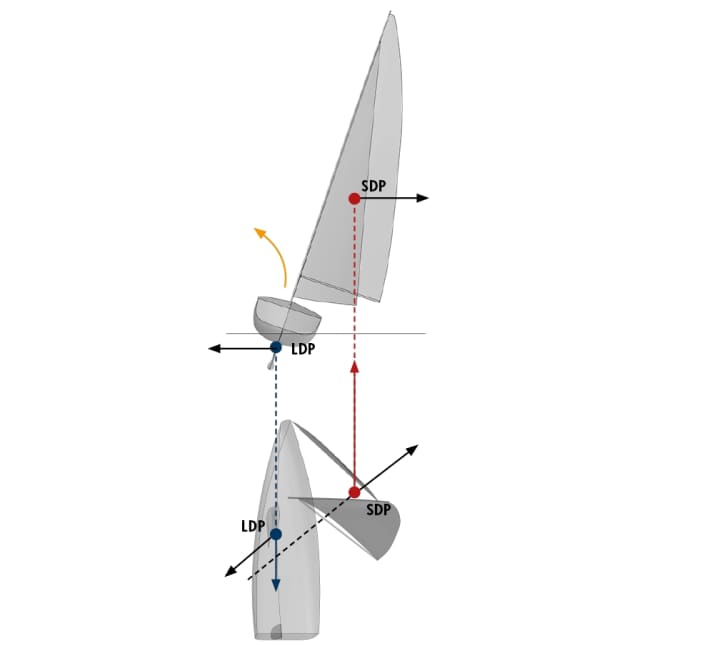




The endeavour of a sailing yacht to change course independently towards the wind, known as upwind yaw, is a positive characteristic. Windward yaw causes the yacht to sail faster. With windward yaw, the yacht also has the ability to actively orientate itself to the wind edge at the cross, making it easier to find the optimum course. Windward yaw also causes rudder pressure and thus provides a better steering feel. In addition, the tendency to windward is a not insignificant safety aspect should the yacht be unsteered.
Windward yaw for more safety
Even if it contradicts nautical principles, there are many conceivable cases in which the helm is left unattended. The helmsman falls asleep, faints or just goes below deck to check the position. For this purpose, a wheel steering can be locked with the spindle, a tiller can be attached with a rope or locked with appropriate fittings. If an autopilot is installed, the yacht is even deliberately left out of your hands and it is tempting to neglect the monitoring.
However, if the autopilot or locking system fails, the yacht can choose its own course. Although this is always a bad thing, the lesser evil is if it is endeavouring to head into the wind. Then at some point the sails will kill and the yacht will stop, perhaps it will still go through the wind, but then it will lie flat. If, on the other hand, it drops uncontrollably, the consequences can be more serious. These include an increase in speed, a barely controllable bow to leeward, a patent gybe with a subsequent sun shot. Not to mention the chaos on board. And nobody wants to imagine what can happen in a densely trafficked area.
On the other hand, the additional safety that windward leeway is supposed to offer when falling overboard is often significantly overestimated. In light wind conditions, luffing up into the wind is usually rather sluggish. The yacht sails a good distance further, and the person who has fallen overboard must be a very good swimmer to reach it again. In tougher conditions, the yacht will go into the wind almost immediately. However, with an inflated lifejacket, it is almost impossible to make progress and the yacht will quickly drift away from the person in the water.
How windward yaw arises
However, this safety aspect is only a side effect of windward leeway. It is actually needed so that a yacht sails better, i.e. faster and more comfortably. Why this is the case can be explained by the rather complex interplay of forces that occur on a sailing yacht.




The desired upwind yaw arises automatically with increasing wind and the associated heeling - often even more than is good. Heeling causes the sail's centre of pressure to shift significantly to leeward and the lateral centre of pressure slightly to windward. At the same time, the parallelogram of forces also shifts. The sail's centre of pressure shifts aft, the lines of force no longer act exactly opposite to each other and a torque is generated to windward.
The simple explanation
Admittedly, this explanation, which every sailing student learns, is perhaps difficult to understand. So here is another, somewhat more striking, albeit not entirely physically correct attempt:
To do this, imagine all forces below the waterline as braking forces and the sails as propulsion forces. The sails pull the yacht forwards, the hull and the appendages brake. If the hull is stationary but the sails are pulling, a torque is created. In an upright position, the yacht would virtually stumble over the bow. When heeling, the "pulling point" of the sails shifts outwards, away from the hull. This creates a lever arm and the yacht turns to windward.



Why windward greed makes you fast
The helmsman counteracts this torque with the rudder. The setting of the blade causes an adjustment in the current and thus an overpressure on the windward side. This pressure generation has different effects.
The lateral pressure point shifts aft, as pressures are suddenly generated at the rudder that were not there before. This brings the sail pressure point and lateral pressure point back into balance and the yacht sails straight ahead.
In addition, the pressure on the rudder is directed to windward, which generates lift and counteracts drift. The total force exerted by the keel and rudder to windward is greater than if the rudder had no angle of attack. This applies increasingly to boats with a split lateral plan, i.e. modern short keels in particular, but also to long keels.

Why long keels hold their course better than modern yachts
These boats generate less lift, as the long keel profile is much less effective and the rudder, which is often unfavourably shaped in terms of hydrodynamics, also generates less lift. However, these boats have another major advantage: the main surface of the keel, which lies far aft, is located behind the centre of gravity of the yacht and acts like a wind vane, greatly simplified. This means that the yacht will always right itself. One reason for the well-known good course-keeping ability of long keels.
Another is the shape of the underwater hull. Yachts with an S-frame are pointed aft or at least have a very narrow stern. Modern yachts with a U-frame, on the other hand, which are designed to offer plenty of space below deck and especially aft for wide berths, have very wide stern sections. Often the hull hardly tapers at all from the centre. This can have advantages not only in terms of comfort, but also in terms of sailing characteristics. When sailing in an upright position such as upwind or downwind, planing conditions are made easier, provided that the overall weight is not too high and the sails develop enough propulsion. In addition, a flat, wide U-frame hull significantly increases dimensional stability.
More upwind manoeuvrability with modern hulls
However, the shape of modern hulls also leads to an increase in windward yaw with increased heel, more so than on older yachts. When upright, the construction centreline and the centreline of the wetted surface - in other words, the line that determines the course through the water - are directly above each other on both yachts. Both go where their bow points without heeling. However, if the modern yacht lies on its side, the shape of the waterline becomes highly asymmetrical and the wetted surface shifts to leeward, aft much more than forward. As a result, the centreline and the course line are no longer superimposed, and the course line also shifts more to leeward aft than forward. It points to windward, while the yacht's course has not changed. She will therefore be listing.





In addition, the stern dips strongly to leeward, again more strongly than the front due to the shape. However, as the yacht always tends to have a balanced displacement ratio, the stern will lean out and the bow will dip more - it will trim on the nose. By levering out the stern, however, the rudder can also deflect. Its effective area is reduced and it generates less pressure in the aft lateral plan, causing the lateral centre of pressure to move forwards. Relatively speaking, the sail's centre of pressure shifts aft and the windward yaw increases.
To counteract this, the rudder must be set more strongly, which increases the resistance and at some point leads to a stall with subsequent overshoot. This can be countered with twin rudder systems.
Long keels hardly trim
The S-Spant yacht is different. As the stern is constricted and deep-drawn, the shape of the waterline remains almost symmetrical even when heeling. Although it also shifts to leeward, which means that the centreline and course line are no longer superimposed, they are still almost parallel, i.e. pointing in the same direction. The yacht sails more stable on course, there is no trimming on the nose and no levelling of the rudder.
The hull and keel shape of the long keeler therefore provide greater course stability or less windward yaw, even when heeling, than a modern yacht. This has already been shown by the large practical comparison.
However, this characteristic of the long keeler is primarily paid for by less volume and therefore less comfort in the harbour. However, its windward tendency also increases with increasing heel due to the shift in the centre of pressure of the sail. The rudder is also less efficient. Although it is not levered out, it often does not have a hydrodynamically favourable shape and is subjected to a turbulent flow by the keel directly in front of it. Even with a long keel, there comes a point at which the rudder can no longer counteract the upwind yaw efficiently, only slows down and then becomes ineffective.
How much windward yaw is good?
The best ratio of heel to rudder angle of attack, i.e. how much windward yaw a sailing yacht should have and how much it can tolerate, varies from design to design. As a rule of thumb, a rudder angle of attack of three degrees to leeward has proven to be the best for wind speeds of 2 to 3 Beaufort, and up to six degrees for wind speeds above that.
At larger angles, the resistance is higher than the lift effect. With tiller steering, the angles can be easily determined with a protractor and marked on the cockpit floor or aft deck with adhesive tape. With wheel steering, you can measure at the quadrant and also mark the wheel with tape. These aids are necessary because otherwise, especially with wheel steering, it is hardly possible to draw conclusions about the rudder angle - if, as is usually the case, a rudder angle sensor is missing.
The markings are also important, as the rudder pressure alone does not provide a reliable indication of the position of the blade in relation to the direction of travel. Rudder pressure is generally an indicator; an increase means an increase in the angle of attack. However, a rudder can also be heavily pre-balanced and provide hardly any feedback despite a large angle of attack, as can a heavily reduced or stiff wheel steering.
With the angles of attack mentioned, a yacht should be able to carry its full sail area at a heel of 20, rarely up to 30 degrees. However, if it breaks to windward much earlier or is even leeward, this indicates an unbalanced design. In this case, you can try to change the mast drop - steepen it to counteract windward yaw, drop it a little to generate more moment to windward. Changes to the rudder blade area and shape can also help. A larger blade normally also generates more pressure aft, causing the lateral pressure point to shift aft. However, it also generates more drag.
How to counteract excessive windward yaw
Underway, the easiest way to avoid too much upwind yaw is to reduce the heel. Firstly, the sails should be trimmed flatter.
Another way to prevent heeling is to increase the righting moment by trimming weight to windward. If both are no longer sufficient, reefing is the order of the day. This shifts the sail's centre of pressure downwards and the heeling decreases
Reefing tip: When it comes to the order of reefing, you should not be fooled by regatta crews. They are more likely to change the headsail than reef the mainsail, but for different reasons. Today's racing sails are so stiff and low-stretch and the trimming devices are so good that they can be pulled flat as a board. Almost only the last third is effective. This has roughly the same effect as a first reef. Cruising mainsails, on the other hand, are often, to put it bluntly, rubber sheets from which the tread depth is difficult to extract, and the older they are, the worse. In addition, the crew can actively operate the mainsheet and traveller on a racing yacht and thus build up pressure again during gust breaks or when the wind drops briefly if the main is not reefed. On a cruising trip, it would hardly be reasonable to expect anyone to operate the mainsheet all the time.
Suddenly greedy to windward?
If you drop from a course high upwind to a half-wind or room sheet course, the yacht can develop its full speed potential. However, anyone expecting a relaxed cruise is often mistaken. The yacht, which was sailing in a balanced manner with the same configuration a moment ago, can suddenly be extremely greedy to windward after falling away and require violent action at the helm. However, although the heeling is significantly less than on the cross, the sail's centre of pressure has also moved outwards again due to the sail being flapped. This also results in a torque to windward. In addition, foresails lose their shape when they are furled, when there is no downward pull on the leech. They open strongly at the top and usually have to be furled too tightly at the bottom, which results in an additional pressure point shift aft.

A latched line block over a furling point as far out as possible, for example on the foot rail, can help a little. However, only reefing, including the mainsail, can really help. If in doubt, it can be taken away completely. The sail pressure point is only as far forward as possible under foresail. Although this will probably cost you a few minutes in terms of arrival time, it makes for a much more comfortable trip. In return, the genoa, which may have been reefed at the cross, can often be completely unfurled again.
As shown, windward leeway is every sailor's friend. It ensures that a yacht sails lively, fast and safe. However, if it becomes too great, it can be annoying or even dangerous. Anyone who sends their guests out to sea on a stubborn boat with a 35-degree temperature and spray on their face will soon be travelling alone. However, if you are aware of the reasons for this behaviour and take the right measures to counteract it, you can reach your destination much more comfortably and pleasantly.

